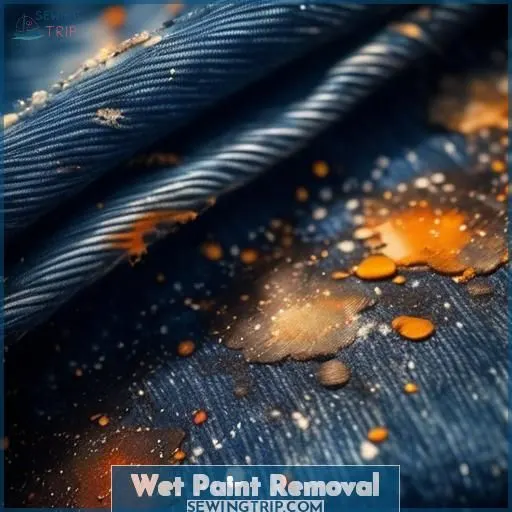This site is supported by our readers. We may earn a commission, at no cost to you, if you purchase through links.

You yearn to express yourself through denim art without ruining your favorite pants.
Easily remove wet acrylic paint stains from jeans by gently scraping excess paint and rinsing with cold water.
For stubborn dried stains, apply isopropyl alcohol before washing.
Properly prepare new jeans for acrylic painting to ensure vibrant, durable designs that won’t bleed or crack after washing.
Table Of Contents
- Key Takeaways
- Does Acrylic Paint Wash Off Jeans?
- Preparing the Denim
- Painting the Base Coat
- Creating the Design
- Painting the Design
- Finishing Touches
- Wet Paint Removal
- Dried Paint Removal With Rubbing Alcohol
- Dried Paint Removal With Paint Remover
- Place Paper Towels Behind the Stain
- Apply Paint Remover and Dab
- Rub With a Brush
- Always Wash Stained Clothing Separately
- Use Gloves When Using Paint Remover
- Use Old Rags or Paper Towels to Avoid Spreading Paint
- Change Out Paper Towels or Cotton Balls as Needed
- Take to a Professional for Oil-based Stain Removal
- Easy to Remove When Wet, Difficult to Remove When Dry
- Water-resistant When Dried
- Isopropyl Alcohol is Most Effective for Removing Dried Stains
- Flush With Cold Water
- Pre-treat With Stain Remover or Detergent
- Wash as Usual in Hottest Water Garment Allows
- Apply Isopropyl Alcohol and Rub Gently
- Check Stain Before Drying to Avoid Setting It
- Repeat Stain Removal Process if Necessary
- Frequently Asked Questions (FAQs)
- Conclusion
Key Takeaways
- Acrylic paint can be difficult to remove from jeans when it is dry, but it can be easily removed when it is wet.
- To remove wet acrylic paint stains, flush with cold water, pre-treat with stain remover or detergent, and wash as usual in the hottest water the garment allows.
- For dried stains, scrape off excess paint, apply isopropyl alcohol and rub gently, flush with cold water, pre-treat with stain remover or detergent, and wash as usual in the hottest water the garment allows.
- Properly preparing the denim for painting by cleaning it and applying a base coat can help ensure vibrant, durable designs that won’t bleed or crack after washing.
Does Acrylic Paint Wash Off Jeans?
Yes, acrylic paint can wash off jeans, but it requires specific cleaning methods. If the paint is still wet, the best approach is to wash the jeans with dishwashing soap while the stain is still wet. If the paint has dried, you can try using rubbing alcohol or turpentine to remove it.
If the stain is stubborn, you may need to use a paint remover and follow the instructions carefully.
Preparing the Denim
To prepare your denim for painting, you’ll need to follow a few steps to ensure a successful outcome. First, clean your denim by washing it with a mild detergent and drying it completely in the dryer. This process helps to remove any dirt or residue that might interfere with your paint application. Additionally, washing and drying the denim may cause the fabric to slightly shrink, which can help the paint adhere better to the fabric.
Next, apply the base coat by mixing 3 parts white acrylic paint with 1 part fabric medium. This mixture will help the paint bind better with the denim and make it more durable, washable, and flexible. Apply 1-2 layers of the base coat to the pocket or taped area using a natural hair paintbrush for clean, streak-free strokes. Once the base coat is dry, you can move on to creating your design.
To create your design, draw the outline with a ballpoint pen and map out the general design before painting. This will help you visualize the final product and ensure accuracy. When painting the design, squeeze small amounts of paint onto a palette and mix fabric medium into the acrylic paint before applying it to the denim. Paint outside the lines to utilize the artists’ tape and allow the paint to dry before removing the tape.
After painting, let the denim dry for 12-24 hours before slowly peeling off the tape. To enhance durability, heat-set the jeans by following the manufacturer’s instructions. Remember to always wash stained clothing separately to avoid spreading paint and use gloves when handling paint remover.
Painting the Base Coat
To paint the base coat, start by mixing 3 parts white acrylic paint with 1 part fabric medium.
Mix 3 Parts White Acrylic Paint With 1 Part Fabric Medium
To create a durable base coat for your denim painting project, you’ll need to mix 3 parts white acrylic paint with 1 part fabric medium. The fabric medium ratio is crucial for achieving the right consistency and ensuring the paint adheres well to the denim fabric. The paint consistency should be thick enough to cover the denim’s color but not so thick that it becomes difficult to apply evenly.
When preparing the denim, apply 1-2 layers of the base coat to the pocket or taped area. The base coat durability is essential for the success of your painting project, as it will provide a solid foundation for the design. White acrylic coverage is important for achieving the desired color and opacity, especially when painting on dark denim fabrics.
Before applying the base coat, make sure to mix the fabric medium into the acrylic paint. The fabric medium will help the paint adhere to the denim and prevent it from washing off. It’s advisable to follow the manufacturer’s recommended ratios for the best results.
Remember to let the painting dry for 12-24 hours before peeling off the tape and heat-setting the jeans to enhance their durability. This will ensure that the base coat is fully dry and the paint is set, preventing any potential damage or smudging.
Apply 1-2 Layers of the Base Coat to the Pocket or Taped Area
After mixing your white acrylic paint with fabric medium in the right ratio, it’s time to dive into the base coat application.
- Slather on 1-2 layers, ensuring each is thin to avoid a goopy mess.
- Patience is key; let each layer dry thoroughly before adding the next.
- Remember, this isn’t just paint; it’s the foundation of your masterpiece on denim.
- Heat-setting is your secret weapon to lock in those layers and ward off future acrylic paint stains.
Creating the Design
To create the design, draw it onto the white base coat using a ballpoint pen. Make sure to map out the general design before you start painting.
Draw the Design Onto the White Base Coat Using a Ballpoint Pen
Wet Paint Removal: Use a butter knife to remove excess paint. Turn the jeans inside out. Flush with warm water. Rub with dish soap and water. Rinse with water.
Dried Paint Removal with Rubbing Alcohol: Scrape off excess paint. Turn the jeans inside out and rinse with water. Rub with rubbing alcohol. Rinse with water. Pretreat with detergent and wash.
Dried Paint Removal with Paint Remover: Use a butter knife to remove excess paint. Turn the jeans inside out. Place paper towels behind the stain. Apply paint remover and dab. Rub with a brush.
Remember to always wash stained clothing separately. Use gloves when using paint remover. Use old rags or paper towels to avoid spreading paint. Change out paper towels or cotton balls as needed. If the stain is oil-based, it’s advisable to take the jeans to a professional for removal.
Acrylic paint stains can be difficult to remove when dry, but they’re easy to remove when wet. They’re water-resistant when dried, and isopropyl alcohol is most effective for removing dried stains. To remove wet acrylic paint stains, flush with cold water, pre-treat with stain remover or detergent, and wash as usual in the hottest water the garment allows. For dried stains, scrape off excess paint, apply isopropyl alcohol and rub gently, flush with cold water, pre-treat with stain remover or detergent, and wash as usual in the hottest water the garment allows. Always check the stain before drying to avoid setting it, and repeat the stain removal process if necessary.
Acrylic paint is versatile and can be used on various surfaces, including fabric. It’s a popular medium for different arts, crafts, and hobbies. When you buy quality acrylic paints, your investment reflects on your finished project. While there are many options for stencil paint, acrylic is the most versatile paint choice for most everyday crafting and project needs.
Map Out the General Design Before Painting
Before you dive into painting your denim jacket, it’s crucial to map out your design.
- Sketch your design: Start by sketching your design on paper or a digital platform. This will give you a clear idea of the overall look and feel of your design.
- Use a stencil or template: If you’re not confident in your drawing skills, consider using a stencil or template to guide your painting. This will help ensure that your design is symmetrical and even.
- Plan your color scheme: Decide on a color scheme for your design. Consider the mood you want to convey and the colors that will best achieve that.
- Consider the placement of your design: Think about where you want your design to be placed on the jacket. Will it be centered or off to one side? This will help you determine the size and shape of your design.
- Test your design: Once you have a rough idea of your design, test it out on a small area of the jacket. This will help you see how the colors and design elements will look on the denim and make any necessary adjustments before you start painting in earnest.
Painting the Design
To begin painting your design, squeeze small amounts of paint onto a palette and fill a paint cup with water. Use a paint puck for brush cleaning, and mix fabric medium into your acrylic paint before you start painting.
Squeeze Small Amounts of Paint Onto a Palette
When diving into your denim masterpiece, keep your paint selection vibrant and varied. Squeeze just small dollops of acrylic onto your palette—this trick keeps your colors fresh and your brush nimble for those intricate detail designs that scream your unique artistic style.
Fill a Paint Cup With Water and Use a Paint Puck for Brush Cleaning
Fill a paint cup with water and use a Paint Puck for brush cleaning while painting the design on your denim jacket.
- Water source: Have a water source nearby, such as a sink or a bucket of clean water, to rinse your brush after each color change or when the paint becomes too thick.
- Paint consistency: Ensure the paint consistency is suitable for the desired effect. If the paint is too thick, add a small amount of water to thin it down. If it’s too thin, add a bit of paint to thicken it.
- Brush maintenance: Keep your brush clean by wiping off excess paint solids with paper towels or old rags before dipping it into the paint. This will prevent the paint from drying on the brush and damaging the bristles.
- Cleanup supplies: Have a paint cup filled with water and a Paint Puck handy for cleaning your brush between colors. The Paint Puck is a handy tool that helps you clean your brush more efficiently by providing a flat surface to rest the brush on while cleaning.
- Palette choice: Choose a palette that suits your painting style and preferences. Acrylic paints can be mixed on a variety of surfaces, including paper plates, plastic palettes, or even your hands.
Mix Fabric Medium Into Acrylic Paint Before Painting
To make your acrylic paint work better on denim and create a more durable finished product, you should mix fabric medium into your paint before applying it to the denim.
Fabric medium is a thick liquid that, when added to acrylic paint, turns it into fabric paint.
It helps the paint adhere better to the denim fabric and reduces the chances of cracking and peeling.
When using fabric medium, it’s essential to mix it with your acrylic paint first, then apply it to the denim.
Use less fabric medium for a more matte finish and more for a shinier, more durable painting.
Remember to mix the fabric medium with the paint on your palette, not directly onto the denim, to create a barrier and prevent the colors from soaking into the denim.
Paint Outside the Lines to Utilize the Artists’ Tape
Painting outside the lines with artists’ tape is crucial for achieving a clean, precise design on your denim jacket.
- Tape Placement: Place the tape around the pocket or desired area on the jacket.
- Fabric Medium Ratio: Mix 3 parts white acrylic paint with 1 part fabric medium.
- Brush Cleaning Frequency: Fill a paint cup with water and use a Paint Puck for brush cleaning.
- Paint Thickness and Drying Time: Apply 1-2 layers of the base coat to the pocket or taped area. Let it dry for 12-24 hours.
Finishing Touches
Once the painting’s dry, you’ll want to slowly peel off the tape to reveal your design. Heat-setting your jeans will enhance the durability of your design, making it last longer.
Let the Painting Dry for 12-24 Hours
Let your painting on denim completely dry for 12-24 hours depending on your climate before you slowly peel off the tape.
This waiting period is crucial for the paint to adhere properly to the fabric, ensuring that the design lasts.
Once the painting is dry, it’s time to heat-set the jeans to enhance their durability.
This process is designed to enhance the fabric durability and prevent the acrylic paint from fading or cracking over time.
Slowly Peel Off the Tape
Once the acrylic paint has dried, it’s time to remove the tape.
Peel it off slowly to avoid damaging the design or causing paint bleeding.
If you’re concerned about the base coat application or design placement, consider applying a layer of clear nail polish remover or liquid laundry detergent before taping to create a barrier.
For oil-based paint, use paint thinner or heat-set the jeans to enhance durability.
Heat-set the Jeans to Enhance Durability
To enhance the durability of your painted denim, it’s essential to heat-set the fabric. This process involves applying heat to the painted area, which helps the paint to bind to the fabric and become more resistant to wear and tear.
- Use an Iron: Turn your jeans inside out and iron the backside of the painting. Be sure not to iron directly on the paint, as this could damage both the painting and the iron. Iron for 5-7 minutes, taking breaks in between to let the denim cool down.
- Use a Clothes Dryer: If you don’t have an iron, you can toss your jeans in the dryer for 15-20 minutes on high heat. Make sure to remove any other items from the dryer to avoid damaging them.
- Use a Hair Dryer: If you don’t have an iron or a clothes dryer, you can use a hair dryer to heat-set your jeans. Set the hair dryer on high heat and blow dry the front and back of the painting for 10-15 minutes, taking breaks in between to let the jeans and hair dryer cool down.
- Peel the Tape Off Before Heat-Setting: Make sure to remove any tape or masking material from the painted area before heat-setting. This will prevent any potential damage to the tape or the iron.
- Let the Painting Dry Before Heat-Setting: It’s important to wait until your painting has had 10-20 hours to dry before heat-setting. This will ensure that the paint has fully adhered to the fabric and is ready for heat treatment.
By following these tips, you can effectively heat-set your painted denim, ensuring that your designs remain vibrant and durable, even after multiple washes.
Wet Paint Removal
If you’ve gotten acrylic paint on your jeans don’t worry, it’s easy to remove. Use a butter knife to remove any excess paint, then turn your jeans inside out and flush them with warm water.
Use a Butter Knife to Remove Excess Paint
| After adding those final touches, it’s time for paint removal. Grab your butter knife, but remember, safety first! This isn’t just about stain prevention; it’s your canvas calling for a new color selection and design inspiration. | Step | Tip |
|---|---|---|
| 1. Safety | Handle the knife with care. | |
| 2. Removal | Gently scrape off the wet paint. | |
| 3. Prevention | Protect areas with tape next time. | |
| 4. Inspiration | Let this guide your next masterpiece. |
Turn Jeans Inside Out
Turning your jeans inside out is a crucial step in removing wet acrylic paint stains.
This simple action allows you to access the backside of the fabric, making it easier to flush out the paint with warm water.
By navigating the complexities of denim care, you’ll ensure the longevity of your design and prevent future stains.
It’s not merely a matter of fabric preparation; it’s a bespoke approach to enhancing your denim’s overall look and feel.
Flush With Warm Water
To remove acrylic paint stains from jeans, you can flush the stained area with warm water.
- Use a Soft Cloth: After flushing with warm water, use a soft cloth to gently blot the stained area. This will help to lift the paint off the fabric without spreading it further.
- Repeat as Necessary: If the paint is still not fully removed, repeat the process with warm water and a soft cloth until the stain is gone.
Rub With Dish Soap and Water
When dealing with wet acrylic paint stains on jeans, you can use a combination of dish soap and water for effective stain removal.
Turn the jeans inside out to expose the stained area.
Rub the stained area gently with a rag soaked in dish soap and water.
Rinse the jeans with warm water to remove the soap and any remaining paint.
Let the jeans dry completely before checking the stain removal results.
If necessary, repeat the process to ensure the stain is completely removed.
Rinse With Water
To remove wet acrylic paint stains from jeans, you can follow these steps:
- Rinse with Warm Water: Start by rinsing the stained area with warm water. This will help to loosen the paint and make it easier to remove.
- Use a Soft Brush or Cloth: Gently scrub the stained area with a soft brush or cloth to help lift the paint off the fabric. Be careful not to rub too hard, as this could damage the denim.
- Flush with Cold Water: After rinsing, flush the area with cold water to remove any remaining paint.
- Pre-treat with Stain Remover or Detergent: If the stain is still visible, pre-treat it with a stain remover or detergent before washing.
- Wash in the Hottest Water Allowed: Wash the jeans in the hottest water the garment allows, as high temperatures can help to break down the paint and make it easier to remove.
Dried Paint Removal With Rubbing Alcohol
To remove dried acrylic paint from jeans, scrape off any excess paint and turn the jeans inside out.
Scrape Off Excess Paint
When it comes to removing dried paint from your denim jeans, scraping off excess paint is a crucial step.
Use a butter knife or other blunt tool to gently remove as much of the dried paint as possible.
The key here is to be meticulous and not force the paint off, as this could damage the denim fibers.
Once you’ve scraped off the excess, pretreat the stain with a cleaning solution, such as rubbing alcohol or a detergent.
Then wash the jeans as usual.
Turn Jeans Inside Out and Rinse With Water
When dealing with dried acrylic paint stains on your jeans, turning them inside out and rinsing with warm water is a crucial step in the stain removal process.
- Prepare the Water: Fill a sink or basin with warm water, ensuring the temperature is suitable for your skin.
- Rinse the Stain: Submerge the jeans in the water, allowing the warm water to gently rinse the affected area.
- Gently Agitate: Use your hands or a soft-bristled brush to gently massage the stain, helping the water work its way into the fabric.
Rub With Rubbing Alcohol
To remove dried acrylic paint stains, turn your jeans inside out and rinse them with water. Then, rub the affected area with rubbing alcohol. This will help break down the paint and make it easier to remove.
Pretreat With Detergent and Wash
After tackling the stain with rubbing alcohol, it’s time to pretreat with detergent. This step is crucial to prevent the stain from setting in your fabric. Apply the detergent directly on the spot, giving your garment a fighting chance in the wash.
Dried Paint Removal With Paint Remover
To remove dried acrylic paint from jeans, first place paper towels behind the stain, then apply paint remover and dab it onto the stain.
Place Paper Towels Behind the Stain
Place paper towels behind the stain.
Apply Paint Remover and Dab
Apply paint remover and dab to remove dried acrylic paint stains from jeans.
Rub With a Brush
Gently rub the brush, loosening dried paint from the bristles.
Always Wash Stained Clothing Separately
When it comes to removing acrylic paint stains from your denim, it’s crucial to follow the right steps to ensure the best results. One of the most important tips is to always wash stained clothing separately. This is especially true when using paint remover, as it can be harsh on fabrics and potentially damage other clothes in the wash.
Here’s a step-by-step guide on how to wash stained denim separately:
- Prepare the Fabric: Before washing, make sure to remove as much excess paint as possible. You can use a butter knife to scrape off the paint, or turn the jeans inside out to flush with warm water. If the paint is dry, you can also rub it with dish soap and water, then rinse with water.
- Use Paint Remover: If the paint is still not removed, you can use a paint remover. Place paper towels behind the stain, apply the paint remover, and dab gently with a clean rag or toothbrush. Be sure to follow the instructions on the paint remover label and use gloves to protect your hands.
- Wash Separately: After treating the stain, wash the denim separately in cold water with a mild detergent. Avoid using hot water, as it can set the stain. If the stain is still visible, repeat the treatment and washing process.
- Dry Carefully: Once the stain is removed, let the denim air dry to prevent any potential damage from heat.
Use Gloves When Using Paint Remover
Always wear gloves when using paint remover for denim care. Ensure proper ventilation and follow safety precautions for stain removal methods.
Use Old Rags or Paper Towels to Avoid Spreading Paint
Stop paint spreading, use old rags or paper towels for cleanup.
- Old rags save your jeans from unwanted splatters.
- Paper towels offer quick fixes to drips and drops.
- Preventing paint spreading keeps your design sharp and clean.
- Proper garment care ensures your artwork lasts on those jeans.
Change Out Paper Towels or Cotton Balls as Needed
Swap cotton balls often, ensuring safety and efficiency in cleanup.
Take to a Professional for Oil-based Stain Removal
For oil-based stains, consider professional cleaning for denim restoration and textile preservation.
Easy to Remove When Wet, Difficult to Remove When Dry
To remove dried acrylic paint stains from denim, you can use paint remover. Here’s a step-by-step guide:
- Scrape off excess paint: Use a butter knife to remove as much excess paint as possible.
- Turn jeans inside out: This will help protect the painted area and make it easier to apply the paint remover.
- Rinse with water: Flush the stained area with warm water to remove any loose paint.
- Apply paint remover: Place paper towels behind the stain to protect the denim. Apply a small amount of paint remover to the stain and dab gently with a clean rag or toothbrush.
- Rub with a brush: If the stain is still visible, use a clean brush to gently rub the paint remover into the stain.
- Wash separately: Always wash stained clothing separately to avoid spreading the paint.
- Use gloves: When handling paint remover, use gloves to protect your hands.
- Change paper towels or cotton balls: If the paper towels or cotton balls become saturated, replace them with fresh ones to avoid spreading the paint.
- Take to a professional: For oil-based stains, it’s best to take the jeans to a professional cleaner.
Water-resistant When Dried
When it comes to painting on jeans, you want your masterpiece to last, and that’s where heat-setting comes in. Heat-setting is the process of applying directed heat to an area of painted fabric to make it permanent, ensuring your painting doesn’t wash, flake, or peel off.
- Preparation: Wait until your painting is completely dry and has had 10-20 hours to dry before heat-setting.
- Ironing: Turn your denim (jeans or jacket) inside out and iron the backside of the painting. Don’t iron on top of the painting itself, as you might end up destroying both the painting and the iron.
- Dryer Method: If you don’t have an iron, you can turn the jeans or jacket inside-out and toss them in the dryer for 15-20 minutes on high-heat.
- Hair Dryer Method: If you don’t have an iron or access to a clothes dryer, you can use a hair dryer to heat-set your jeans. Set the hair dryer on high heat and blow dry the front and back of the painting for 10-15 minutes total, taking breaks in between to let the jeans and hair dryer cool down.
Once your jeans are heat-set, they should feel more flexible and will hold up better through wearing and washing. Remember, always peel the tape off before heat-setting to avoid any accidents.
Isopropyl Alcohol is Most Effective for Removing Dried Stains
When it comes to removing acrylic paint from denim, isopropyl alcohol is a highly effective solution for removing dried stains. This liquid has some solvent action on the acrylic binder, making it ideal for breaking down and dissolving the paint.
- Scrape off excess paint: Use a butter knife or old toothbrush to remove as much paint as possible from the denim surface.
- Turn jeans inside out: This will help prevent the paint from spreading to other areas of the jeans.
- Apply isopropyl alcohol: Soak a cotton ball or cloth with isopropyl alcohol and gently dab it onto the stained area. Be sure to avoid using too much alcohol, as it can damage the denim.
- Rub gently: Gently rub the alcohol-soaked cloth onto the stain, allowing the alcohol to break down the paint.
- Rinse with cold water: After the paint has been dissolved, rinse the jeans with cold water to remove any remaining alcohol and paint residue.
- Pre-treat with detergent: Before washing the jeans, pre-treat the stained area with a laundry detergent to help remove any remaining paint.
- Wash in the hottest water allowed: Wash the jeans in the hottest water recommended for the fabric, as high temperatures can help break down the paint further.
Flush With Cold Water
Chill out, cold water’s your denim’s ally against stubborn stains.
Pre-treat With Stain Remover or Detergent
Pre-treating your clothes with a stain remover or detergent is an essential step in removing acrylic paint stains.
- Detergent Effectiveness: Choose a laundry detergent that’s effective in breaking down acrylic paint. Dish soap, for example, can dissolve tough acrylic paint stains when used in combination with warm water.
- Stain Remover Options: There are several stain remover options available, such as rubbing alcohol, hairspray, denatured alcohol, or paint thinner. It’s essential to test these products on an inconspicuous area first to ensure they won’t damage the fabric.
- Pre-wash Treatment: Before washing your garment, pre-treat the stain with a stain remover or detergent to loosen up the paint and prepare it for removal.
- Washing Instructions: Follow proper washing instructions, using the appropriate water temperature, to ensure the stain is effectively removed.
Wash as Usual in Hottest Water Garment Allows
Wash as Usual in Hottest Water Garment Allows (Dried Paint Removal with Paint Remover)
Apply Isopropyl Alcohol and Rub Gently
Apply isopropyl alcohol and rub gently for effective dried paint removal.
Check Stain Before Drying to Avoid Setting It
Before you dry your painted jeans, it’s crucial to check the stains to avoid setting them. This step is particularly important when dealing with acrylic paint stains, which can be difficult to remove once they’ve dried.
- Inspect the Stain: Look closely at the painted area to ensure there are no visible spots or smudges.
- Touch the Stain: Gently touch the painted area with your fingers to feel for any rough or tacky spots that may indicate the paint is still wet.
- Blot the Stain: Use a clean cloth or paper towel to blot the area. If the paint transfers onto the cloth, it’s not yet dry and should be treated accordingly.
If you find that the paint is still wet, you can repeat the drying process, ensuring that you let the paint dry completely before peeling off the tape and heat-setting the jeans. Remember, the key to successfully removing acrylic paint stains is to act quickly before the paint dries.
Repeat Stain Removal Process if Necessary
If the acrylic paint stain on your jeans is dried, you’ll need to repeat the stain removal process to ensure thorough removal.
- Scrape off excess paint: Use a butter knife to remove as much excess paint as possible from the stain. Be gentle to avoid damaging the fabric.
- Turn jeans inside out: This will make it easier to access the stain and prevent the paint from spreading to other areas.
- Rinse with water: Flush the stain with cold water to help loosen the dried paint.
- Pre-treat with stain remover or detergent: Apply a stain remover or detergent directly to the stain. Let it sit for a few minutes to allow the chemicals to break down the paint.
- Wash as usual in hottest water garment allows: Wash the jeans in the hottest water temperature that’s safe for the fabric. This will help to further dissolve the paint.
- Check stain before drying: After washing, inspect the stain to ensure it has been completely removed. If not, repeat the process.
Frequently Asked Questions (FAQs)
Can acrylic paint cause allergic reactions?
Yes, acrylic paint contains chemicals that can irritate skin and cause allergic reactions in some people.
How does weather affect acrylic paint drying?
Humid conditions slow drying, so avoid painting in muggy weather. Extreme heat or cold also impact drying times. A moderate temperature around 70°F with low humidity provides the ideal environment for your acrylic paint project.
Are there eco-friendly acrylic paint options?
You bet! Eco-conscious brands offer plant-based acrylics free from harsh chemicals.
Can acrylic paint change denim’s texture?
A stitch in time saves nine – acrylic paint can stiffen denim’s soft, pliable texture. So, handle your jeans with care post-painting to preserve their coveted lived-in feel.
Is acrylic painting on denim machine washable?
Acrylic paint on denim is washable if heat-set properly. Carefully follow instructions — it can stiffen fabric or cause cracking if not done right.
Conclusion
Ultimately, does acrylic paint wash off jeans? Yes, but with some effort. Wet stains rinse easily, while dried ones require isopropyl alcohol or paint remover. By properly prepping denim and mixing fabric medium into acrylic paints, you’ll create vibrant, durable designs.
Follow stain removal steps diligently for the best results when painting goes awry.














